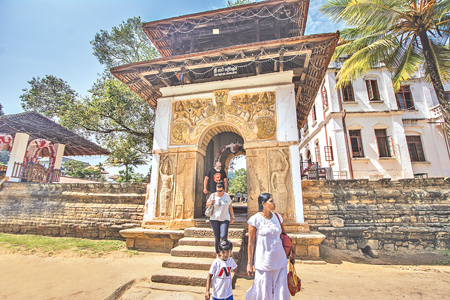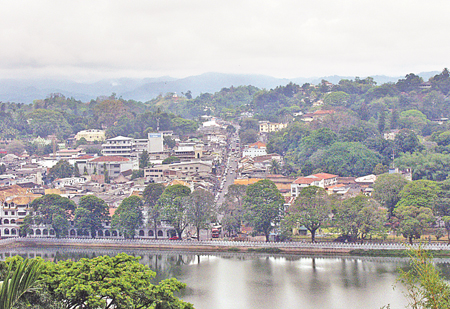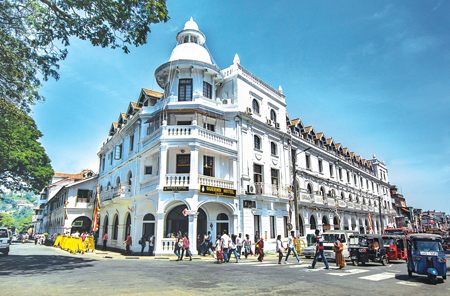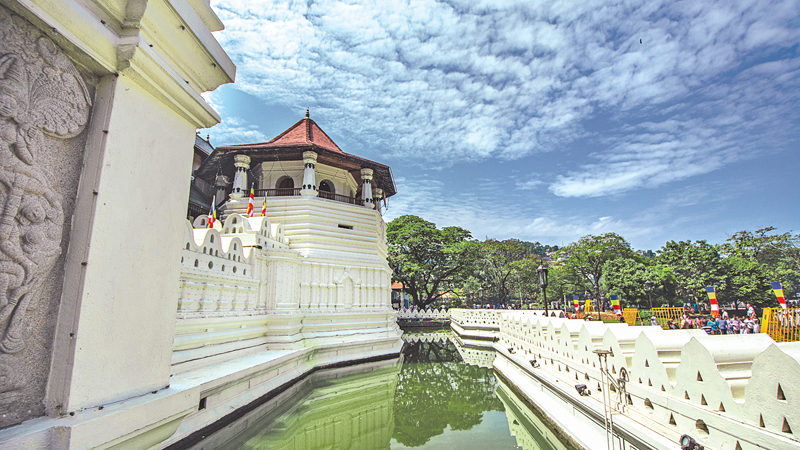 Protected by nature by the surrounding hills, looped by the Mahaweli Ganga and blessed by natural beauty, the Kandy city which has a history of over three centuries, had gained fame due to the location of the most revered temple of the Buddhists, the Temple of the Sacred Tooth Relic.
Protected by nature by the surrounding hills, looped by the Mahaweli Ganga and blessed by natural beauty, the Kandy city which has a history of over three centuries, had gained fame due to the location of the most revered temple of the Buddhists, the Temple of the Sacred Tooth Relic.
It is noted for the ancient lake at the centre and salubrious climate. Kandy has been declared a World Heritage City by the United Nations Educational, Scientific and Cultural Organization, (UNESCO).
The month of August is Kandy’s moment of glory. It is the best time of the year to be in Kandy, to take on a journey of cultural discovery as the Temple of the Sacred Tooth Relic celebrates its annual street parade, a time of jubilation as the city comes alive with colour from August 10-20.
Esala Perahera
The Esala Perahera in Kandy is one of the most wonderful events in Sri Lanka. It takes place for ten nights each year, just before the full moon in August, boasting an astounding procession of elephants bedecked in silk, brocade or velvet, harnessed in gold, silver and precious stones, mounted by the highest dignitaries from the ministries in traditional costumes, preceded and followed by marvellous Kandyan dancers in rich costumes of pearls in honour of the Buddha’s tooth relic.

The entrance gate of the Natha Devale
The Sacred Tooth Relic is carried by the largest of the elephants in a golden coffer where it sits upon a golden lotus leaf, with a lock of golden hair in memory of its arrival in Princess Hemamala’s hair.
To a background of drum beats, gong strokes and clashing cymbals, the enchanting name of Kandy rings out. Each day, at sunrise, at 11 am or 6 pm, the chanting in the Temple of the Sacred Tooth Relic can be heard where a cohort of the faithful, pilgrims and visitors enter with a lotus flower in their hands to bow before the precious relic.
Kandy was the last royal capital on the island. It is still Sri Lanka’s religious capital. It has possessed the Sacred Tooth Relic since 1590. The Sacred Tooth Relic, of course, reached the island far earlier in 311 A. D., carried in the hair of an Indian princess, Hemamala. It had been kept for its protection and public veneration in its beautiful temples in Anuradhapura, Polonnaruwa, Kurunegala, Seethavaka and all the successive and fugitive capitals of the Sinhala kings. Sometimes it had to be hidden in the forests, in caves and even in grinding stones to protect it from invaders and colonisers such as Portuguese.
For many years, it was a symbol of royal Sinhala power. Today, it represents the Buddhist fervour of the Sinhala people. This is in keeping with Kandy itself which was the heart of the resistance movement during the Portuguese, Dutch and British colonisation and was the last kingdom of the island.
The first thing to do in Kandy is to visit the Temple of the Sacred Tooth Relic. In the evening, this visit to the temple, illuminated with thousands of lights is magical. There is a captivating slow movement, like a prayer which rises, towards the room where the Sacred Tooth Relic is on display in the seven golden receptacles shaped like dagabas. Drummers and flute players strike the rhythm of this traditional procession while women on their knees, hands together at their foreheads, recite sacred texts in front of the Sacred Tooth Relic.

The Kandy city and lake seen from the hill over the city
In the octagonal shaped corner pavilion – Pattirippuwa, facing the Kandy Lake, built by King Sri Wickrama Rajasinha in the beginning of the 19th century to view the pageant and address the people, there is an outstanding library belonging to the bhikkhus.
The Temple of the Sacred Tooth Relic features elegant architecture, standing proud above ditches and canals; its raised roofs, its galleries of sculptured columns, its enormous tabernacle of sculptured wood, its many buildings where the bhikkhus live and work, are particularly noteworthy. It is true that the Sinhala sovereigns made a point of embellishing it.
The Temple of the Sacred Tooth Relic was part of the royal palace built by King Wimaladharmasuriya the first in the 16th century; it was destroyed by the Portuguese, then rebuilt and enlarged by King Kirti Sri Rajasinha in the 18th century.
Archaeological museum
The king and queen each had their own palaces in this enclosure. The king’s have become an archaeological museum. The queen’s, on a hill overlooking the lake, with perforated wooden galleries and many rooms has been transformed into a national museum; it contains a wealth of souvenirs of the last kings of Kandy.
In Kandy, four other temples are extremely important with respect to religion although they are dedicated to Hindu divinities; they are, nevertheless, honoured by the Buddhists: the Pattini Devale stands just in front the Temple of the Sacred Tooth Relic where Pattini, the goddess of chastity and health is venerated. Alongside, the Natha Devale, the oldest of these temples built in the 8th and 9th centuries is the Mahayana centre of worship for Natha. The Maha Vishnu Devale, also close to the Temple of the Sacred Tooth Relic is devoted to Upulvan, the name given to Vishnu by the Buddhists while a little farther on stands the Kataragama Devale, the sanctuary of the god of victory.
These four devalas also participate in the great Esala Perahera procession with their own cortege of elephants, dancers and musicians. The procession is particularly grandiose.
Summer palace

A Colonial residence turns into a hotel – Queen’s Hotel
The Kandy Lake, dating back only to 1807 is enchanting. The British built a walk around it, an opportunity to admire the superb landscape and the adorable island where King Sri Wickrama Rajasinha had a summer palace built for his harem and which is now a flower garden.
Around the lake are a succession of Kandy-style architecture buildings, like the Malwatta monastery, the oldest religious building in the area, existing from the 14th century and the ancient colonial residences which have been transformed into the elegant hotels such as Queen’s Hotel and Swiss Hotel in an extraordinary setting. But it is also worth climbing onto the hills to gain a complete view of the town in its setting of greenery.
If you want to experience the real essence of Kandy, you must come during the Esala Perahera, which in 2024 falls between August 10-20, when the majesty of Kandy’s past is paraded in a spectacular all-dancing, all-drumming festival culminating on the full moon Poya day.









